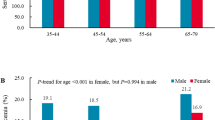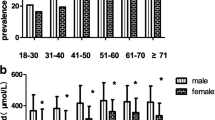Abstract
Economy has developed rapidly in China, and the clustering of cardiovascular risk factors in subjects increased remarkably over the past two decades. However, no data are available regarding the temporal prevalence of hyperuricemia and its correlates in this rapidly developing area, especially in the inland area. The cross-sectional survey was based on a random sample of 4,218 residents aged 35–64 years in the Jinan area. Hyperuricemia was defined as serum uric acid ≥416 μmol/L in men and ≥357 μmol/L in women. Subjects underwent physical examination and fasting blood testing. Complete data were available for analysis from 1,979 men and 2,062 women. The age-adjusted prevalence of hyperuricemia was 6.4 % for men and 2.1 % for women. The prevalence of hyperuricemia was greater in urban (6.7 %) than in rural areas (1.7 %) of Jinan city. Multivariate logistic regression models revealed hyperuricemia associated with hypertriglyceridemia [men: odds ratio (OR) = 6.101, 95 % confidence interval (CI) 4.064–9.159; women: OR = 7.103, 95 % CI 3.578–14.099] and high serum creatinine level (men: OR = 2.603, 95 % CI 1.602–4.230; women: OR = 5.237, 95 % CI 2.667–10.284). Hyperuricemia was also significantly associated with male sex, urban residence, hypertension, obesity, and hypercholesterolemia. Age (1-year increase) was negatively associated with hyperuricemia in men but positively associated with hyperuricemia in women. In conclusion, the prevalence of hyperuricemia is higher in urban than rural areas of Jinan, China. Male sex, urban residence, hypertension, obesity, hypercholesterolemia, hypertriglyceridemia, and high serum creatinine level contributed to hyperuricemia in this population.


Similar content being viewed by others
References
Bulpitt CJ (1975) Serum uric acid in hypertensive patients. Br Heart J 37:1210–1215
World Health Organization (1995) Physical status: the use and interpretation of anthropometry. Report of a WHO Expert Committee. World Health Organization technical report series 854, pp 1–452
Chelchowska M, Ambroszkiewicz J, Gajewska J, Laskowska-Klita T, Leibschang J (2007) The effect of tobacco smoking during pregnancy on concentration of uric acid in matched-maternal cord pairs. Przegl Lek 64:667–670
Chen S, Du H, Wang Y, Xu L (1998) The epidemiology study of hyperuricemia and gout in a community population of Huangpu District in Shanghai. Chin Med J 111:228–230
Choi HK, Atkinson K, Karlson EW, Willett W, Curhan G (2004) Alcohol intake and risk of incident gout in men: a prospective study. Lancet 363:1277–1281
Choi HK, Liu S, Curhan G (2005) Intake of purine-rich foods, protein, and dairy products and relationship to serum levels of uric acid: the Third National Health and Nutrition Examination Survey. Arthr Rheum 52:283–289
Chu NF, Wang DJ, Liou SH, Shieh SM (2000) Relationship between hyperuricemia and other cardiovascular disease risk factors among adult males in Taiwan. Eur J Epidemiol 16:13–17
Chungtei C (2003) Hyperuricemia and gout among Taiwan Aborigines and Taiwanese-prevalence and risk factors. Chin Med J 116:965–967
Conen D, Wietlisbach V, Bovet P et al (2004) Prevalence of hyperuricemia and relation of serum uric acid with cardiovascular risk factors in a developing country. BMC Public Health 4:9
Cuspidi C, Valerio C, Sala C et al (2007) Lack of association between serum uric acid and organ damage in a never-treated essential hypertensive population at low prevalence of hyperuricemia. Am J Hypertens J Am Soc Hypertens 20:678–685
Daudon M, Traxer O, Conort P, Lacour B, Jungers P (2006) Type 2 diabetes increases the risk for uric acid stones. J Am Soc Nephrol JASN 17:2026–2033
Ebrahimpour P, Fakhrzadeh H, Heshmat R, Bandarian F, Larijani B (2008) Serum uric acid levels and risk of metabolic syndrome in healthy adults. Endocr Practice Off J Am Coll Endocrinol Am Assoc Clin Endocrinol 14:298–304
Fang J, Alderman MH (2000) Serum uric acid and cardiovascular mortality the NHANES I epidemiologic follow-up study, 1971–1992. National Health and Nutrition Examination Survey. JAMA, J Am Med Assoc 283:2404–2410
Feig DI, Johnson RJ (2003) Hyperuricemia in childhood primary hypertension. Hypertension 42:247–252
Feig DI, Kang DH, Johnson RJ (2008) Uric acid and cardiovascular risk. New Engl J Med 359:1811–1821
Ferns GA, Lanham J, Dieppe P, Galton DJ (1988) A DNA polymorphism of an apoprotein gene associates with the hypertriglyceridaemia of primary gout. Hum Genet 78:55–59
Fuchs FD, Chambless LE, Whelton PK, Nieto FJ, Heiss G (2001) Alcohol consumption and the incidence of hypertension: The Atherosclerosis Risk in Communities Study. Hypertension 37:1242–1250
Gotoh M, Li C, Yatoh M, Iguchi A, Hirooka Y (2005) Serum uric acid concentrations in type 2 diabetes: its significant relationship to serum 1,5-anhydroglucitol concentrations. Endocr Regul 39:119–125
Hakoda M (2008) Epidemiology of hyperuricemia and gout in Japan. Nippon rinsho. Jpn J Clin Med 66:647–652
He J, Gu D, Wu X et al (2005) Major causes of death among men and women in China. New Engl J Med 353:1124–1134
Jackson L, Taylor R, Faaiuso S, Ainuu SP, Whitehouse S, Zimmet P (1981) Hyperuricaemia and gout in Western Samoans. J Chronic Dis 34:65–75
Ko YC, Huang MC, Wang TN, Chang SJ, Tsai LY, Tu HP (2005) Prevalence and risk factors associated with dyslipidaemia in children and adolescents among ethnic groups in Taiwan. Public Health 119:489–497
Kosugi T, Nakagawa T, Kamath D, Johnson RJ (2009) Uric acid and hypertension: an age-related relationship. J Hum Hypertens 23:75–76
Langlois M, De Bacquer D, Duprez D, De Buyzere M, Delanghe J, Blaton V (2003) Serum uric acid in hypertensive patients with and without peripheral arterial disease. Atherosclerosis 168:163–168
Li D, Yu X, Zhou X, Siriamornpun S, Wahlqvist ML (2006) Uric acid status and its correlates in Hangzhou urban population. Asia Pac J Clin Nutr 15:102–106
Li Y, Stamler J, Xiao Z, Folsom A, Tao S, Zhang H (1997) Serum uric acid and its correlates in Chinese adult populations, urban and rural, of Beijing. The PRC-USA Collaborative Study in Cardiovascular and Cardiopulmonary Epidemiology. Int J Epidemiol 26:288–296
Liberopoulos E, Miltiadous G, Elisaf M (2002) Hypouricaemia as a marker of a generalized proximal tubular damage in alcoholic patients. Alcohol Alcohol 37:472–474
Liu CS, Li TC, Lin CC (2003) The epidemiology of hyperuricemia in children of Taiwan aborigines. J Rheumatol 30:841–845
Lu Z, Dong B, Wu H et al (2009) Serum uric acid level in primary hypertension among Chinese nonagenarians/centenarians. J Hum Hypertens 23:113–121
Moriwaki Y, Yamamoto T, Takahashi S, Tsutsumi Z, Higashino K (1995) Apolipoprotein E phenotypes in patients with gout: relation with hypertriglyceridaemia. Ann Rheum Dis 54:351–354
Nakamura K, Sakurai M, Miura K et al (2012) Alcohol intake and the risk of hyperuricaemia: a 6-year prospective study in Japanese men. Nutr Metab Cardiovasc Dis NMCD 22:989–996
Nan H, Qiao Q, Dong Y et al (2006) The prevalence of hyperuricemia in a population of the coastal city of Qingdao, China. J Rheumatol 33:1346–1350
Ong KL, Cheung BM, Man YB, Lau CP, Lam KS (2007) Prevalence, awareness, treatment, and control of hypertension among United States adults 1999–2004. Hypertension 49:69–75
Reilly KH, Gu D, Duan X et al (2008) Risk factors for chronic obstructive pulmonary disease mortality in Chinese adults. Am J Epidemiol 167:998–1004
Slater PE, Kaufmann NA, Friedlander Y, Stein Y (1985) Effects of smoking and physical activity on serum uric acid in a Jerusalem population sample. Ann Hum Biol 12:179–184
Wallace KL, Riedel AA, Joseph-Ridge N, Wortmann R (2004) Increasing prevalence of gout and hyperuricemia over 10 years among older adults in a managed care population. J Rheumatol 31:1582–1587
Yue JR, Huang CQ, Dong BR (2012) Association of serum uric acid with body mass index among long-lived Chinese. Exp Gerontol (Epub ahead of print)
Acknowledgments
This work was partly supported by the National Natural Science Foundation of China Grants 81100207 and 30900607.
Author information
Authors and Affiliations
Corresponding authors
Rights and permissions
About this article
Cite this article
Yang, J., Liu, Z., Zhang, C. et al. The prevalence of hyperuricemia and its correlates in an inland Chinese adult population, urban and rural of Jinan. Rheumatol Int 33, 1511–1517 (2013). https://doi.org/10.1007/s00296-012-2589-8
Received:
Accepted:
Published:
Issue Date:
DOI: https://doi.org/10.1007/s00296-012-2589-8




